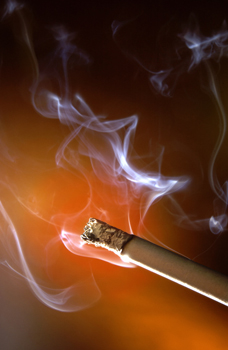The Potential Threat of Thirdhand Smoke
November 2014
The Potential Threat of Thirdhand Smoke
Scientists have been looking at the dangers of secondhand smoke for years. It’s been linked to cancer, heart disease, asthma, and other health problems. But they’ve only started to study the potential threat of thirdhand smoke.
What is thirdhand smoke?
Thirdhand smoke is also called residual tobacco smoke. It forms as secondhand smoke begins to go away indoors. Tiny particles of nicotine and other substances settle on walls, floors, and furniture. They linger long after the smell of cigarette smoke has disappeared. Over time, these substances may change into toxic chemicals.
One recent study looked at how widespread and unhealthy thirdhand smoke might be. Researchers used a vacuum cleaner to collect dust from 46 smokers’ and nonsmokers’ homes. They then studied the samples. They looked for nicotine and chemicals called tobacco-specific nitrosamines (TSNAs). Several TSNAs are known to cause cancer.
Surprisingly, the researchers found thirdhand smoke in all of the homes. But concentrations were up to 60 times higher in homes where smokers lived. The results suggest this residue may be easily spread. Even more concerning: Such exposure may raise a person’s risk for cancer. That may be especially true for children younger than 6 years of age.
Should you be concerned?
You may breathe in thirdhand smoke particles, accidently get them in your mouth, or absorb them through your skin. This exposure may be a particular concern for children. They tend to spend more time on and around surfaces that may be covered with thirdhand smoke. For example, they may crawl on the floor or put their mouth on walls and furniture.
Many experts are still on the fence about thirdhand smoke and its potential to harm human health. Past research suggests it may be possible. A recent study with mice found liver and lung damage in those animals exposed to thirdhand smoke. Another study showed that residual smoke could affect human cells.
Despite this evidence, thirdhand smoke has not been shown to directly cause cancer or other health problems. But research is ongoing. In the meantime, banning smoking in your home and car may help reduce thirdhand smoke particles. Such a policy may be especially important for parents.
Quitting smoking will not only improve your health, but also save you money! Find out how much.
Quit-Smoking Aids May Help You Stop
You may already know: Quitting smoking isn't easy. But doing so can improve your health. It can also protect you and loved ones from second- and thirdhand smoke. Need some help quitting? Try one of these smoking-cessation aids:
Quit lines. When you call a quit line, you can talk with someone who's trained to help people quit smoking. It's free, and you can call almost any time. Here's where to find a quit line.
Nicotine patches, gum, or lozenges. These over-the-counter aids can help you fight cravings.
Nicotine nasal spray or inhaler. These prescription devices can quickly put nicotine in your body to ease withdrawal symptoms.
Zyban and Chantix. These prescription medications reduce cravings and withdrawal symptoms. But they can have side effects. Talk with your doctor to see if they might be right for you.
Online resources
Updated:
March 21, 2017
Sources:
Cigarette Smoke Toxins Deposited on Surfaces: Implications for Human Health. M. Martins-Green, et al. PLoS One. 2014;9(1):e86391., Exposure to Nitrosamines in Thirdhand Tobacco Smoke Increases Cancer Risk in Non-Smokers. N. Ramirez, et al. Environment International. 2014;71:139-47., Thirdhand Smoke Beliefs of Parents. J. Drehmer, et al. Pediatrics. 2014;133(4):e850-56., When Smokers Move Out and Nonsmokers Move In: Residential Thirdhand Smoke Pollution and Exposure. G. Matt, et al. Tobacco Control. 2011;20(1):1-19.
Reviewed By:
Turley, Ray, BSN, MSN
